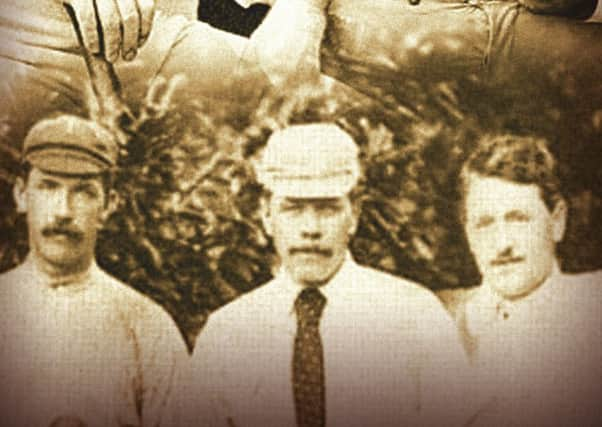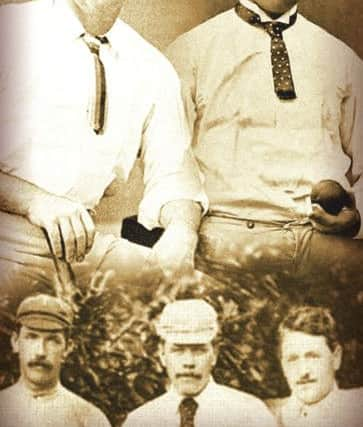Bygones: When '˜Happy Jack' found his land legs to help launch Test cricket


On March 15, 1877, an England team containing five Yorkshire players took on Australia in Melbourne.
The names of those players have now all but disappeared from common knowledge.
Advertisement
Hide AdAdvertisement
Hide AdThere was George Ulyett, a fun-loving fellow known as ‘Happy Jack’, and one of the best all-rounders of the 19th century.


A dynamic batsman, an aggressive fast bowler and a brilliant fielder, Ulyett was the Ben Stokes of his day in terms of his ability to change a match with bat or ball.
There was Tom Emmett, another attacking all-rounder and one of the early characters of the professional game.
“Never was there a man of higher vitality, of more inexhaustible good humour than Tom Emmett,” wrote the former cricketer/administrator/historian Harry Altham.
Advertisement
Hide AdAdvertisement
Hide AdThere was Andrew Greenwood, a diminutive and courageous batsman, and there was Allen Hill, a powerful right-arm fast bowler.


Last but not least, there was Tom Armitage, another fine all-rounder with a strapping physique.
To say that Armitage was not feeling at his best on March 15, 1877, however, is an understatement.
According to some reports, he was barely able to stand up straight after England arrived in Melbourne less than 24 hours before the start of the match following a fraught sea journey from New Zealand.
Advertisement
Hide AdAdvertisement
Hide AdAlong with several of his team-mates, Armitage suffered severe sea-sickness during the voyage and had not fully recovered by the start of the match.
However, he had to play because England were down to only 11 available players after wicketkeeper Ted Pooley had been thrown in prison.
Pooley, of Surrey, had bet a man named Ralph Donkin that he could forecast the score of each member of the local 18 in a game against the tourists in Christchurch.
Pooley nominated nought as each man’s score – an old tactic against poor opposition and, sure enough, a good number of ducks followed.
Advertisement
Hide AdAdvertisement
Hide AdBut Donkin smelt a rat and refused to pay, leading to a scuffle.
Pooley was fined £5 for assault and both he and Alf Bramall, the England team’s baggage man, were detained in New Zealand on charges of wilfully damaging Donkin’s property before eventually being acquitted.
It was all a far cry from today’s era of pre-match practice days and meticulous strength and conditioning, with the tourists practically beaten before the first Test had started.
At the time, it was not actually classed as a Test match but as a meeting between a combined New South Wales and Victoria XI against James Lillywhite’s professional touring team.
Advertisement
Hide AdAdvertisement
Hide AdNot for another 17 years would Test cricket, as it is known today, come into being when a list of what constituted the ‘Test matches’ up to then was agreed upon in England and Australia.
Neither the five Yorkshiremen nor any of the remaining 17 players at Melbourne had any idea that they were taking part in a fixture that would prove to be of such ground-breaking significance.
However, the game was still significant in a different way in that it was the first time that an Australian side had met an England one on equal terms – ie in an 11-a-side contest as opposed to 15 against 11, or 18 against 11, and so on.
Prior to that, it was not considered that an Australian 11 would be sufficiently strong to compete with the English, with first-class cricket in Australia then still in its infancy.
Advertisement
Hide AdAdvertisement
Hide AdBut two wins by New South Wales 15s over Lillywhite’s men, plus one by a Victorian 15, led to the idea for a ‘Grand Combination Match’ – the official title of the first Test.
Both sides were heavily depleted, though, with England missing leading amateurs such as WG Grace and Australia without the likes of star fast bowler Fred Spofforth, who refused to play because he disapproved of the choice of wicketkeeper.
Notwithstanding internal politics, the game was a great success from an Australian point of view, the home side winning by 45 runs.
Charles Bannerman, who faced the first ball from Notts’s Alfred Shaw, scored Test cricket’s first run when he cut the next delivery for a single en route to Test cricket’s first century.
Advertisement
Hide AdAdvertisement
Hide AdBannerman made 165 before retiring hurt when a ball from Yorkshire’s Ulyett struck him on the second finger of his right hand.
Australia closed on 245-9 and gained a shock lead of 49 as the tourists were dismissed for 196, Harry Jupp top-scoring with 63 despite “inflammation of the eyes”.
Billy Midwinter starred with the ball, taking 5-78 with his medium-pacers against the country of his birth.
Midwinter, who later that year represented his native Gloucestershire, played eight Tests for Australia and four for England before tragically dying, aged 39, in a Melbourne asylum after the death of his wife and two children.
Advertisement
Hide AdAdvertisement
Hide AdUlyett, wicket-less in the first innings, captured three in the second as Australia were dismissed for 104, Shaw returning 5-38.
Chasing 154, Ulyett struck the second top score of 24 as England were bowled out for 104 to hand the hosts a famous victory, Bedford-born Tom Kendall taking 7-55 with his left-arm spinners.
The Australian press naturally went to town, The Australiasian going so far as to say that the tourists were the weakest side to have visited the colonies – “notwithstanding the presence among them of Shaw, who is termed the premier bowler of England”.
The paper made clear: “If Ulyett, Emmett and Hill are fair specimens of the best fast bowling in England, all we can say is, either they have not been in their proper form in this Colony or British bowling has sadly deteriorated.”
Advertisement
Hide AdAdvertisement
Hide AdAlfred Shaw, by common consent England’s best bowler at the time, wrote in his memoirs – with more than a hint of the prevailing attitude of the period – that “for the time being the defeated Englishmen and their associates in the Colonies had to be content to eat humble pie – sweetened, it is true, with the thought that it was members of their own race who had offered it – but humble pie all the same”.
Following the success of the ‘Grand Combination Match’, a ‘Return Combination Match’ was held in Melbourne a fortnight later.
This time, England, had recovered their equilibrium and their land legs and ran out winners by four wickets.
The match was a triumph for ‘Happy Jack’ Ulyett, who top-scored with 52 in the first innings and 63 in the second.
England returned home with honours even, and with the great institution of Test cricket – although no-one knew it at the time – under way.